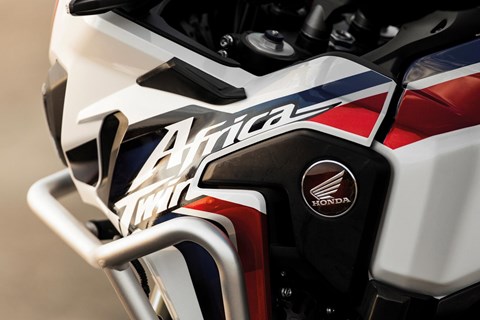► New Honda Africa Twin tested in our Handlebars review
► Legendary name returns on a 94bhp dirt-ready adventure bike
► Good enough to challenge BMW’s ruling R1200GS?
Just as the SUV niche has exploded in popularity, so the adventure bike market is hot in the two-wheeled world. There are strong parallels too, with both styles of vehicle combining rugged, go-anywhere styling and ambition with plenty of real-word practicality, including bump-flattening suspension, comfortable riding positions and plenty of scope for a generous cargo.
BMW’s R1200GS has dominated adventure bike sales for years and almost everyone, from Suzuki and Kawasaki to performance Europeans brands Ducati and KTM, offers a rival, each with a different take on the road/off-road compromise. Now Honda has a serious contender in the CRF1000L Africa Twin.
I dimly recall the name…
The name has lain dormant for more than a decade, having been first introduced back in 1989. Part of the original wave of Japanese adventure bikes, together with Yamaha’s Super Ténéré (itself brought back from the dead in 2010), the first Africa Twins became legendary Hondas, up there with the game-changing FireBlade superbike and the VFR750 sports tourer. But by the time the adventure bike market really took off, with BMW’s superb first-generation R1200GS, Honda offered only the tubby and tough-to-love Varadero, a bike about as likely to fire wanderlust as a pair of NHS crutches.
The new Africa Twin is a very different animal. Priced from £10,849 (£11,689 for the DCT version tested here), the new bike looks like a Dakar dirt racer, offers 21st century rider-assist electronics (ABS and traction control) and comes with either a six-speed manual gearbox or Honda’s slick, adjustable twin-clutch semi-auto, a unique transmission in the market.
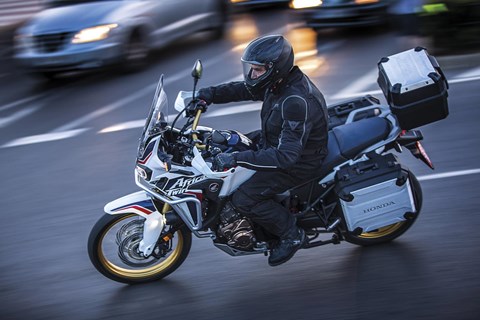
And that jumble of letters before the name – CRF1000L – is significant. The Varadero was a more rounded ‘XL’. The CRF badge is used on Honda’s range of fierce off-road competition bikes, and marks the Africa Twin out as a true dual-purpose machine, if you want it to be. The spec sheet backs that up, with a 21-inch front wheel (to effortlessly traverse rough ground) rather than a road-biased 19-inch front, as fitted to the likes of the Yamaha and BMW.
The Honda’s also modestly powered. Where the R1200GS develops north of 120bhp and the madcap KTM and Ducati more like 150bhp, the Honda chimes in with a smooth and perfectly linear 94bhp: less spectacular when you’re chasing the horizon on hot grippy tarmac but more usable and less likely to bring about an accident when you’re off-road and drifting between trees on muddy tracks.
In it for the long haul?
Absolutely. For all its Baja-bashing pretensions the Africa Twin is an accomplished road bike and a fine all-rounder. Assuming you’re tall enough to comfortably work around the seat height (adjustable between 850 and 870mm), the riding position is perfection. What’s more the high-set handlebars mean the Honda works whether you’re sitting down or standing on the footpegs, for greater control off-road. Impressive given that most bikes of this ilk are only comfortable doing one or the other.
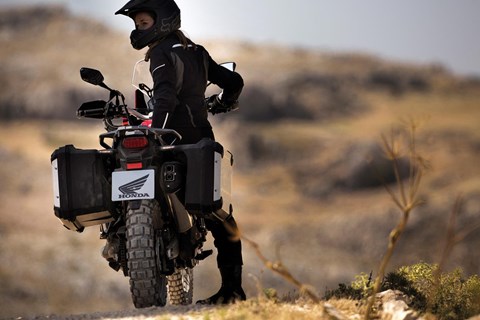
The Honda’s an effortless distance machine, thrumming along with enough power to overtake with confidence and the suspension travel and stability to deal with anything, from big lean on smooth roundabouts to effortless progress on gnarled and rutted back roads.
Vibration is well-suppressed for a parallel twin and the optional DCT gearbox makes for laudably low-stress progress – you need only worry about taking in the scenery and mentally planning that three-week adventure to the mountain roads and desert trails of Morocco.
The instrumentation is sparse but nicely clear and ordered and the heated handlebar grips a welcome luxury. While the 18.8-litre tank can’t deliver the 250+ miles of the GS Adventure or Multistrada Enduro, distance riders will appreciate the Honda’s fine ergonomics, standard-fit cruise control and user-friendly hard luggage (£285 for the top box and carrier, £525 for the panniers), even if there’s been no discernible attempt to really design what are just three big black Tupperware boxes.
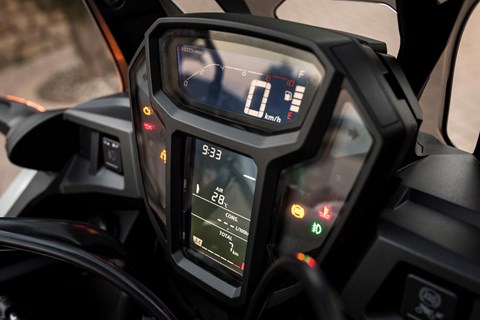
All is serene then, or it would be were it not for the pretty tiresome buffeting from the windscreen’s turbulent blast. The screen’s adjustable for height but I failed to find a comfortable set-up in any of its positions, and suspect doing so would require experimentation with aftermarket screens and screen extenders. It’s a common issue with adventure bikes, and something to check on that test ride.
So far, so worthy – is it fun?
This isn’t a bike you grab by the scruff of the neck but, given its off-road prowess, that’s to be expected. (And if you’ll never hit the dirt perhaps the more expensive and intense Ducati Multistrada or KTM Adventure might better suit your needs).
But once you’re dialled in to the way the Honda swings slightly ponderously but accurately from one side to the other, that big front wheel bringing a very likeable sense of security to proceedings, the CRF can be ridden at a fair clip on the road, the wide ’bars putting you firmly in control and the nicely forward-set weight distribution giving you confidence in the front tyre.
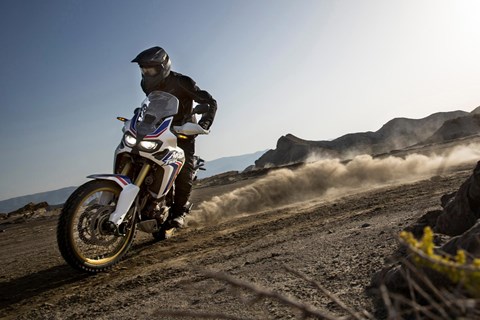
Find a suitable track and you can instantly disable the ABS on the rear wheel, for tighter rear-brake-assisted turns, and the multi-stage traction control lets you find your feet on corner-exit without risk of throwing your £11k adventure bike into the bushes. Where rival machines can feel like a liability off-road, the Honda’s latent dirt ability is inspiring.
If you dream of a week exploring the dusty labyrinthine tracks of the Pyrenees before cruising home through back-road France, it’s hard to think of a bike that more convincingly melds the qualities required for both.
And DCT?
A mixed bag. You’ll pay a little more for it (£800) and there’s a modest weight penalty (10kg). Opt for it and the bike goes without a gearlever (put one back on for £320) or clutch lever, and replaces the latter with a handbrake for safe parking on slopes (since you can’t leave the bike in gear). Three modes are offered: normal, manual and sport, with three shift profiles within sport, which ramp up with keener downshifts and increased propensity to run to high revs before shifting up.
Normal short-shifts like a cab driver, sometimes managing to get into fourth gear at 30mph, which the parallel twin doesn’t feel all that happy about. Predictably Sport is the opposite, quickly shifting down when you crack open the throttle (good news) but refusing to shift back up long after the truck you overtook is gone (frustrating).
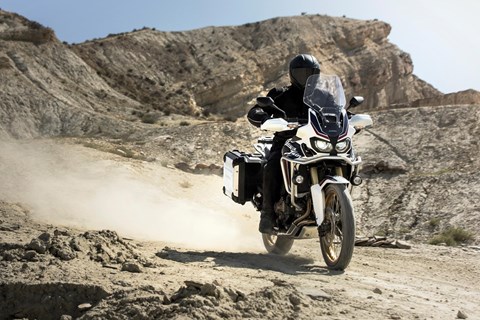
Play with the different shift maps and you’ll find an acceptable compromise but it’ll always be just that, a compromise, so inevitably you find yourself switching to manual. Defeating the entire object of the exercise? Not so. You shift up with the index finger of your left hand and down with a push of the same hand’s thumb.
Within an hour you develop the muscle memory for unthinking shifts, and find DCT worming its way into your affections. The easy downshifts free up brain space when you’re streaking towards a tight corner, while the upshifts are so spookily fast and smooth you’re happy to prod the button even mid-corner, without fear of upsetting the bike. Carry a passenger and the system’s a godsend, offering such smooth shifts your pillion won’t even feel them.
Developing the new skill set required for consistently smooth low-speed manoeuvres takes a little longer: without a clutch lever U-turns and the like ask that you balance the throttle on the clutch bite point, often working against the rear brake to stop the bike running away from you.
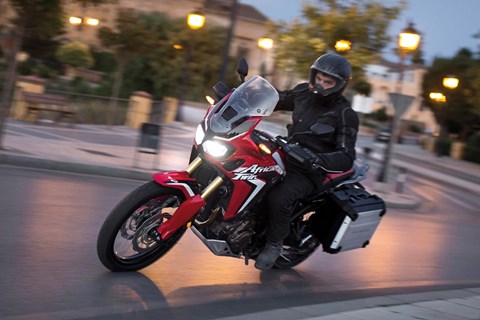
Select G mode and the clutch take-up is more aggressive, as befits off-road riding, but experienced pilots will miss a clutch lever. Its absence means clutch-assisted wheelies to help the front wheel over obstacles are off the menu, as is feathering the clutch lever to curb excess wheelspin. But on the plus side the bike’s impossible to stall and, if you regularly take passengers, you’ll love DCT.
Verdict
Just as Honda’s automotive arm is undergoing a renaissance, spearheaded by the Civic Type R and NSX, so the new Africa Twin is the product of an r&d team rediscovering its mojo. Built to meet (and in some cases exceed) a clear list of objectives, the CRF1000 impresses with its beautifully judged road/off-road balance, its slick functionality and the thoughtfully implemented technology.
In the final reckoning the Honda’s a really likeable series of paradoxes. It bristles with clever systems but needs no introduction – you can just jump on and ride. It’ll devour 450-mile days on the road but it’s also fun on a for-the-hell-of-it Sunday morning blast. And while it’s ready for some pretty serious off-road riding, that ability doesn’t compromise its road manners.
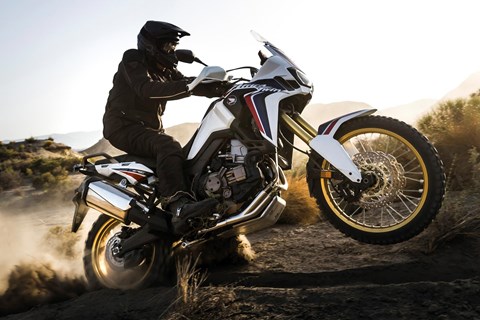
You’d be forgiven if you came away wanting a slicker standard of finish, particularly to the cockpit. The switchgear looks and feels old enough to have been on the original Africa Twin, for starters, and the gold anodised handlebar is plain nasty. We’d understand if you’d want a touch more power, too – after all, with 94bhp it can’t hope to like with the likes of the 160bhp Multistrada Enduro.
There’s no such thing as a free lunch, however, and a big part of the Africa Twin’s appeal is its keen pricing – which undercuts the likes of the KTM Adventure and GS Adventure by some £4k.
And judging by the bike’s runaway sales success (by July it was the third best-selling bike in the UK in 2016, with more than a 1000 registered), Honda looks to have balanced the sums beautifully.
At a glance
Handling ★★★★
Performance ★★★
Usability ★★★★
Feelgood factor ★★★★★
CAR’s Rating ★★★★
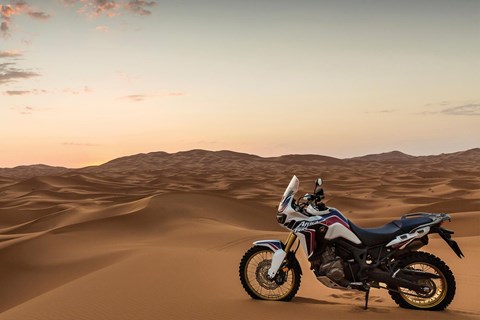
Specifications
Price when new £10,849 (£11,689 DCT)
On sale in the UK Now
Engine 998cc 8v parallel twin, 94bhp @ 7500rpm, 72lb ft @ 6000rpm
Transmission six-speed manual or six-speed paddleshift auto
Performance 115mph top speed (est), 48mpg (est)
Weight/made from 232kg(242kg DCT)/steel, aluminium, plastic
Dimensions (length/width/height/wheelbase/seat height in mm) 2335/930/1475/1575/850 or 870 (adjustable)
Read more features
